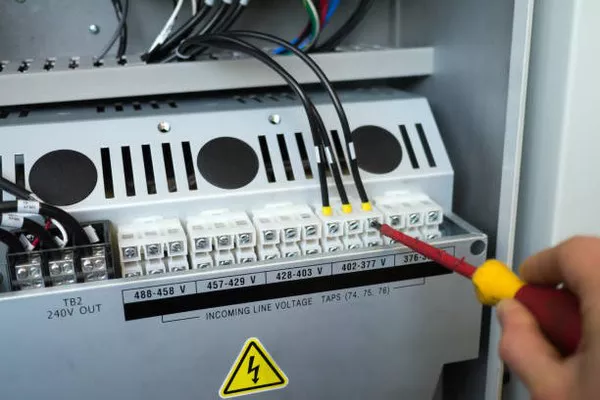Current transformers (CTs) are essential components in electrical power systems, enabling accurate measurement and protection against electrical faults. They play a crucial role in transforming high current levels into manageable, measurable values for instruments and protective devices. In this article, we delve into the workings of current transformers, exploring their functions, applications, and significance in modern electrical engineering.
What is a Current Transformer (CT)?
A current transformer is a type of instrument transformer designed to produce a scaled-down replica of the primary current flowing through it. This scaled-down current is proportional to the actual current in the circuit and is suitable for measurement and protection purposes. CTs consist of a primary winding and a secondary winding, wound around a magnetic core made of ferromagnetic material. The primary winding is connected in series with the circuit carrying the current to be measured, while the secondary winding is connected to instruments or protective devices.
Function of Current Transformers
The primary function of a CT is to step down high currents to a standard value suitable for measurement by meters, instruments, and relays. CTs achieve this by utilizing the principle of electromagnetic induction. When current flows through the primary winding, it creates a magnetic field around the winding. This magnetic field induces a proportional current in the secondary winding according to Faraday’s law of electromagnetic induction. The secondary current is then used for measurement or relay operation.
Key Components of a Current Transformer
Primary Winding: The primary winding of a CT is connected in series with the electrical conductor through which the current flows. The number of turns in the primary winding determines the transformation ratio of the CT.
Secondary Winding: The secondary winding produces a reduced current that is proportional to the primary current. The secondary winding usually has a much larger number of turns compared to the primary winding to achieve a step-down effect.
Magnetic Core: The magnetic core of the CT is typically made of laminated silicon steel or other ferromagnetic materials. It serves to concentrate the magnetic flux generated by the primary current, which in turn induces a current in the secondary winding.
Applications of Current Transformers
Current transformers are widely used in various applications across the electrical industry:
Metering: CTs are used to measure current in power systems for billing and monitoring purposes. The secondary current output from the CT is fed into current meters or energy meters to determine power consumption.
Protection: CTs play a critical role in protective relay systems. They provide inputs to protective relays that detect abnormal current conditions, such as overcurrent or short circuits, and initiate protective actions such as tripping circuit breakers.
Monitoring and Control: Current transformers are used in control circuits to provide feedback on current levels for operational purposes, such as motor control and process automation.
Ground Fault Protection: CTs are employed in ground fault protection systems to detect leakage currents and protect against electrical hazards.
Types of Current Transformers
There are different types of current transformers based on their construction and application:
Wound CTs: These CTs have a primary winding and a secondary winding wound around a magnetic core. They are commonly used for measuring and protection applications.
Bar-Type CTs: In bar-type CTs, the primary conductor itself acts as the primary winding. These CTs are used in high-voltage applications where insulation is critical.
Bushings CTs: Bushing CTs are designed to fit around the bushings of power transformers or circuit breakers to monitor current flow.
Rogowski Coil CTs: Rogowski coil CTs use a flexible coil to measure alternating currents, providing advantages in applications where a standard CT cannot be used due to physical constraints.
Importance of Accurate Current Measurement
Accurate current measurement is vital for several reasons:
Efficient Energy Management: Proper measurement of current helps utilities and industries optimize energy usage and identify areas for improvement.
Preventive Maintenance: Monitoring current levels allows for the early detection of equipment faults, helping to prevent costly breakdowns and downtime.
Safety: Accurate measurement is essential for ensuring the safety of electrical systems and personnel by promptly detecting abnormal current conditions.
Considerations for Selecting a Current Transformer
When selecting a CT for a specific application, several factors must be considered:
Primary Current Range: Choose a CT that can handle the maximum current expected in the circuit without saturating.
Accuracy Class: The accuracy of the CT must be suitable for the intended measurement or protection requirement.
Burden: Ensure that the CT can provide the required secondary current under the specified burden (load) conditions.
Frequency: CTs are designed for specific frequencies; ensure that the CT matches the system frequency (e.g., 50 Hz or 60 Hz).
Challenges and Innovations in Current Transformer Design
Despite their widespread use, current transformers face challenges in certain applications, such as high-voltage environments or with complex waveform measurements. Innovations in CT design, including digital CTs and optical CTs, aim to address these challenges by improving accuracy, response time, and compatibility with modern digital systems.
Conclusion
Current transformers are indispensable components in electrical power systems, enabling safe and accurate measurement of current levels for a wide range of applications. By stepping down high currents to manageable levels, CTs play a crucial role in metering, protection, and control of electrical systems. As technology evolves, so do CT designs, with ongoing innovations aimed at enhancing performance and reliability in modern electrical engineering applications.

